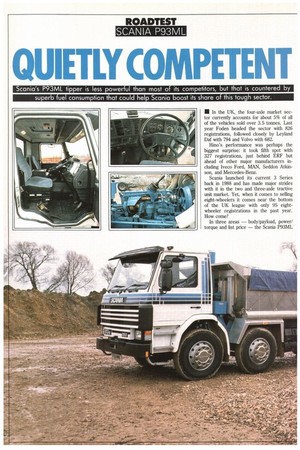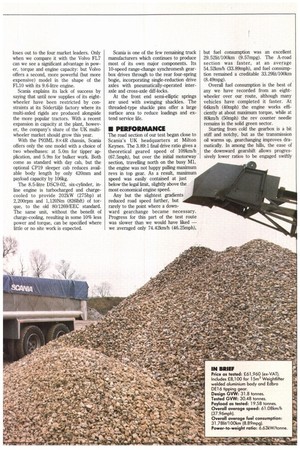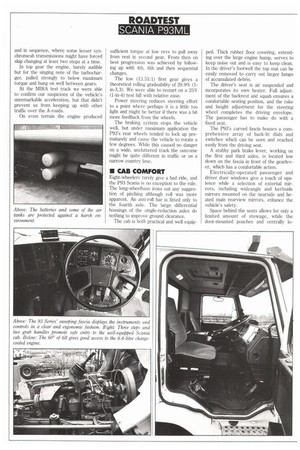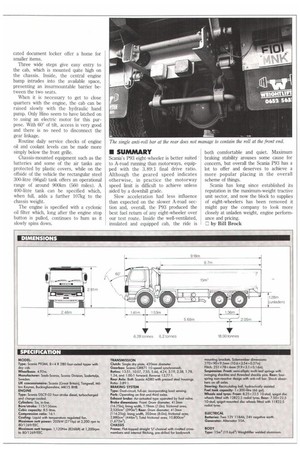QUIETLY COMPETENT
Page 66

Page 67

Page 68

Page 69

If you've noticed an error in this article please click here to report it so we can fix it.
• In the UK, the four-wde market sector currently accounts for about 5% of all of the vehicles sold over 3.5 tonnes. Last year Foden headed the sector with 826 registrations, followed closely by Leyland Daf with 794 and Volvo with 682.
Hino's performance was perhaps the biggest surprise: it took fifth spot with 327 registrations, just behind ERF but ahead of other major manufacturers including Iveco Ford, MAN, Seddon Atkinson, and Mercedes-Benz.
Scania launched its current 3 Series back in 1988 and has made major strides with it in the two and three-axle tractive unit market. Yet, when it comes to selling eight-wheelers it comes near the bottom of the UK league with only 95 eightwheeler registrations in the past year. How come?
In three areas — body/payload, power/ torque and list price — the Scania P93ML loses out to the four market leaders. Only when we compare it with the Volvo FL7 can we see a significant advantage in power, torque and engine capacity: but Volvo offers a second, more powerful (but more expensive) model in the shape of the FL10 with its 9.6-litre engine.
Scania explains its lack of success by saying that until now supplies of its eightwheeler have been restricted by constraints at its SCidertilije factory where its multi-aided rigids are produced alongside the more popular tractors. With a recent expansion in capacity at the plant, however, the company's share of the UK multiwheeler market should grow this year.
With the P93ML 8x 4R chassis, Scania offers only the one model with a choice of two wheelbases: at 5.0m for tipper application, and 5.9m for bulker work. Both come as standard with day cab, but the optional CP19 sleeper cab reduces available body length by only 420mm and payload capacity by 106kg.
The 8.5-litre USC9-02, six-cylinder, inline engine is turbocharged and chargecooled to provide 202kW (275hp) at 2,200rpm and 1,120Nm (8261bft) of torque, to the old 80/1269/EEC standard. The same unit, without the benefit of charge-cooling, resulting in some 10% less power and torque, can be specified where little or no site work is expected.
Scania is one of the few remaining truck manufacturers which continues to produce most of its own major components. Its 10-speed range-change synchromesh gearbox drives through to the rear four-spring bogie, incorporating single-reduction drive axles with pneumatically-operated interaxle and cross-axle cliff-locks.
At the front end semi-elliptic springs are used with swinging shackles. The threaded-type shackle pins offer a large surface area to reduce loadings and extend service life.
• PERFORMANCE
The road section of our test began close to Scania's UK headquarters at Milton Keynes. The 3.89:1 final drive ratio gives a theoretical geared speed of 1091cm/h (67.5mph), but over the initial motorway section, travelling north on the busy Ml, the engine was not happy pulling maximum revs in top gear. As a result, maximum speed was easily contained at just below the legal limit, slightly above the most economical engine speed.
Any but the slightest gradients reduced road speed further, but rarely to the point where a downward gearchange became necessary. Progress for this part of the test route was slower than we would have liked — we averaged only 74.42Icrn/h (46.25mph), but fuel consumption was an excellent 29.521it/100km (9.57mpg). The A-road section was faster, at an average 54.52km/h (33.89mph), and fuel consumption remained a creditable 33.291ff/100km (8.49mpg).
Overall fuel consumption is the best of any we have recorded from an eightwheeler over our route, although many vehicles have completed it faster. At 641un/h (40mph) the engine works efficiently at about maximum torque, while at 801cm/h (50mph) the rev counter needle remains in the solid green sector.
Starting from cold the gearbox is a bit stiff and notchy, but as the transmission oil warms up, gearchanging improves dramatically. In among the hills, the ease of the downward gearshift allows progressively lower ratios to be engaged swiftly and in sequence, where some lesser synchromesh transmissions might have forced skip changing at least two steps at a time.
In top gear the engine, barely audible but for the singing note of the turbocharger, pulled strongly to below maximum torque and hung on well between gears.
At the MIKA test track we were able to confirm our suspicions of the vehicle's unremarkable acceleration, but that didn't prevent us from keeping up with other traffic over the A-roads.
On even terrain the engine produced sufficient torque at low revs to pull away from rest in second gear. From then on best progression was achieved by following up with 4th, 6th and then sequential changes.
The low (13.51:1) first gear gives a theoretical rolling gradeability of 29.9% (1in-3.3). We were able to restart on a 25% (1-in-4) test hill with relative ease.
Power steering reduces steering effort to a point where perhaps it is a little too light and might be better if there was a bit more feedback from the wheels.
The braking system stops the vehicle well, but under maximum application the P93's rear wheels tended to lock up prematurely and cause the vehicle to rotate a few degrees. While this caused no danger on a wide, uncluttered track the outcome might be quite different in traffic or on a narrow country lane.
• CAB COMFORT
Eight-wheelers rarely give a bad ride, and the P93 Scania is no exception to the rule. The long-wheelbase irons out any suggestion of pitching although roll was more apparent. An anti-roll bar is fitted only to the fourth axle. The large differential housings of the single-reduction axles do nothing to improve ground clearance.
The cab is both practical and well equip
ped. Thick rubber floor covering, extending over the large engine hump, serves to keep noise out and is easy to keep clean. In the driver's footwell the top mat can be easily removed to carry out larger lumps of accumulated debris.
The driver's seat is air suspended and incorporates its own heater. Full adjustment of the backrest and squab ensures a comfortable seating position, and the rake and height adjustment for the steering wheel completes the driving envelope. The passenger has to make do with a fixed seat.
The P93's curved fascia houses a comprehensive array of back-lit dials and switches which can be seen and reached easily from the driving seat.
A stubby park brake lever, working on the first and third axles, is located low down on the fascia in front of the gearlever, which has a comfortable action.
Electrically-operated passenger and driver door windows give a touch of opulence while a selection of external mirrors, including wideangle and kerbside mirrors mounted on the nearside and heated main rearview mirrors, enhance the vehicle's safety.
Space behind the seats allows for only a limited amount of stowage, while the door-mounted pouches and centrally lo cated document locker offer a home for smaller items.
Three wide steps give easy entry to the cab, which is mounted quite high on the chassis. Inside, the central engine hump intrudes into the available space, presenting an insurmountable harrier between the two seats.
When it is necessary to get to close quarters with the engine, the cab can be raised slowly with the hydraulic hand pump. Only Hino seem to have latched on to . using an electric motor for this purpose. With 600 of tilt, access is very good and there is no need to disconnect the gear linkage.
Routine daily service checks of engine oil and coolant levels can be made more simply below the front grille.
Chassis-mounted equipment such as the batteries and some of the air tanks are protected by plastic covers, while on the offside of the vehicle the rectangular steel 300-litre (66ga1) tank offers an operational range of around 900km (560 miles). A 400-litre tank can be specified which, when full, adds a further 107kg to the chassis weight.
The engine is specified with a cyclonic oil filter which, long after the engine stop button is pulled, continues to hum as it slowly spins down.
• SUMMARY
Scania's 1193 eight-wheeler is better suited to A-road running than motorways, equipped with the 3.89:1 final drive ratio. Although the geared speed indicates otherwise, in practice the motorway speed limit is difficult to achieve unless aided by a downhill grade.
Slow acceleration had less influence than expected on the slower A-road section and, overall, the P93 produced the best fuel return of any eight-wheeler over our test route. Inside the well-ventilated, insulated and equipped cab, the ride is both comfortable and quiet. Maximum braking stability arouses some cause for concern, but overall the Scania P93 has a lot to offer and deserves to achieve a more popular placing in the overall scheme of things.
Scania has long since established its reputation in the maximum-weight tractive unit sector, and now the block to supplies of eight-wheelers has been removed it might pay the company to look more closely at unladen weight, engine performance and pricing.
7_ by Bill Brock




































































































































































































